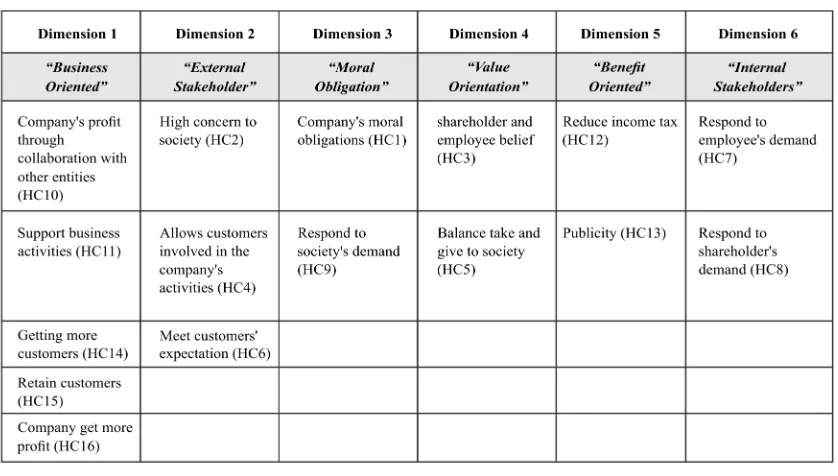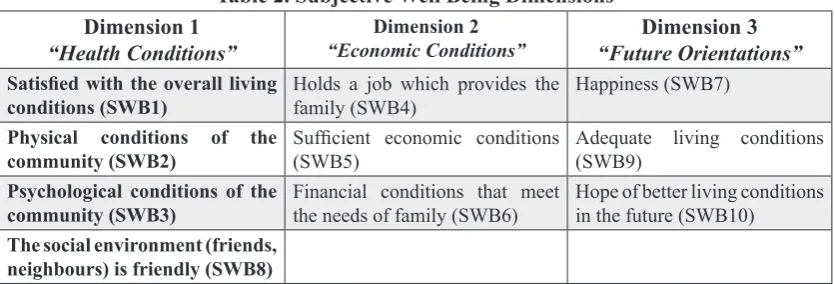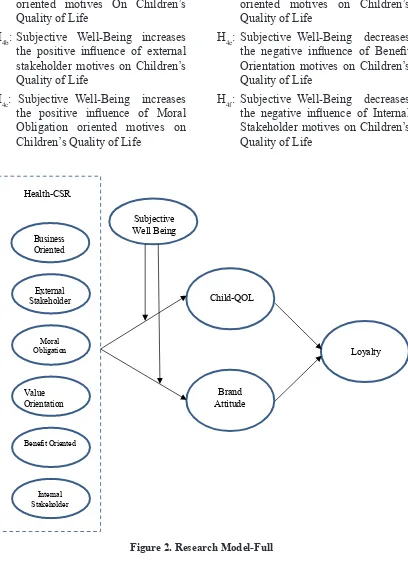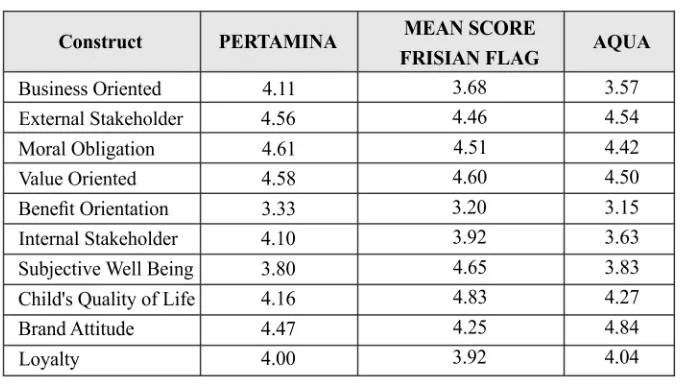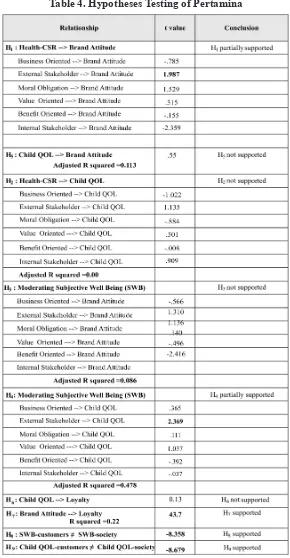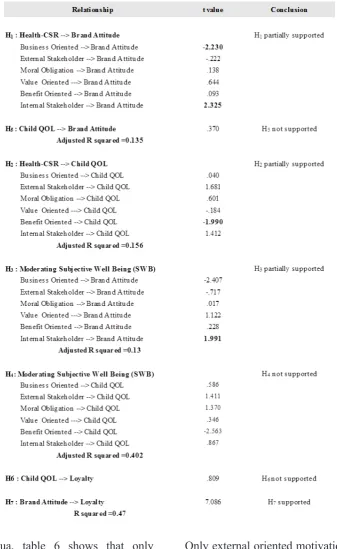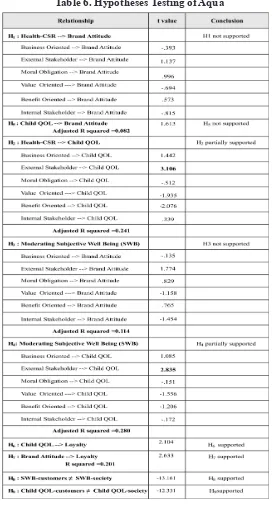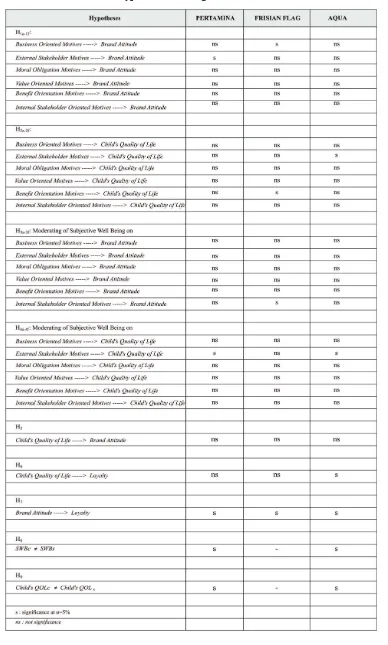and Business Application 5 (3) 173-198 ©UB 2017 University of Brawijaya Malang, Indonesia http://apmba.ub.ac.id
The Impact of Health Corporate Social Responsibility
(CSR) Activities on Brand Attitude and Customers’
Loyalty in Two Bıg Cıtıes of Indonesıa
Elevita Yuliatia* Tengku Ezni Balqiahb Nurdin Sobaric
Rifelly Dewi Astutid
abcdManagement Department, Faculty of Economics and Business, University of
Indonesia, Depok, Indonesia
Abstract
This paper examined whether companies’ health Corporate Social Responsibility (CSR) activities – CSR activities concerning health and well-being of mothers and children – had impacts on perceived quality of life, consumers’ brand attitude, and customers’ loyalty, with subjective well-being served as moderating variable. The research used both exploratory and conclusive research. Surveys were conducted in two cities in Indonesia, Makassar, and Surabaya. Respondents of this research were from two different groups.
The first group was composed of customers of three companies operating in Indonesia.
The companies were Pertamina, Danone-Aqua, and Frisian Flag. The second group was composed of community members in the area where the health CSR activities were conducted. The total number of respondents were 240 respondents, consists of 90 customers and 30 community members from each city. The data were analyzed using multiple regressions to test 9 research hypotheses. The results showed that there were different perceived motivations from different CSR activities of the three companies,
and these motivations had different paths to influence social and business performance
of the companies.
Keywords
CSR, Health CSR, Corporate Social Responsibility, Brand Attitude, Children Quality of Life, Subjective Well-Being, Customer Loyalty
Received: 2 February 2017; Accepted: 1 March 2017; Published Online: 28 April 2017
DOI: 10.21776/ub.apmba.2017.005.03.4
Introduction
Corporate Social Responsibility (CSR) has become an important concern for companies around the world, not only in the developing countries but in
An example of CSR implementation in developed countries is in Sweden. Bhave (2009) in Itotenaan, Samy, and Bampton (2014) stated that Sweden was
amongst the first in the world to promote
businesses to be environmentally responsible. Another example is in the Netherlands. The Netherlands Government had established the MVO Nederland (CSR Netherlands) to interface between government and corporations on CSR matters and provides information to Dutch businesses on CSR implementation (CSR Netherland, 2010 in Itotenaan, et.al., 2014).
As for developing countries, an example of CSR implementation can be found in Malaysia. One concept of CSR in Malaysia is the legal obligations of corporations to contribute to the improvement of a community’s living standards by participation in philanthropic activities (Abdul Rashid and Ibrahim, 2002; Mohamed and Sawandi, 2007 in Ismail, Alias, and Rasdi, 2015). The involvement of private corporations in community-based activities, especially those involving CSR, is necessary to contribute to human resource and community development (Ismail, Alias, and Rasdi, 2015).
Corporate Social Responsibility
(CSR), as defined by the European
Commission (2001), is “a concept whereby companies integrate social and environmental concerns in their business operations and in their interaction with their stakeholders on a voluntary basis” (European Commission, 2001, in Oberseder, Schlegelmich, and Murphy, 2013). Not only that CSR can increase
profit but it also has impacts on social and
environmental issues (Peloza and Shang, 2011). Many CSR activities are driven directly or indirectly by stakeholders (Kiessling, Isaksson, and Yasar, 2015). CSR and sustainability are the two themes commonly used in discussions about the economic contribution of business, social, and environmental as consequences of business activities (Torugsa, O’Donohue, and Hecker, 2013).
Various types of CSR activities deliver different values for different parties associated with the CSR activities. CSR activities have impacts on corporate
profits and the value of a company
(Malik, 2015; Gonzalez-Rodriguez, Diaz-Fernandez, and Simonetti, 2015). Some researchers had shown that CSR
activities influenced consumer behavior
(Maignan and Ferrell, 2004; Luo and Bhattacharya, 2006, Du, Bhattacharya, and Sen, 2007), and develop the corporate image, furthermore increase customer loyalty (Plewa, Conduit, Quester, and Johnson, 2015). Blomback and Scandelius (2013) concluded from their research that the presence of corporate heritage in CSR communication was positively related to responsible brand image with consumers. An interesting
finding from their research was that
corporate heritage identity on its own
did not influence consumers’ perception
of the responsible brand image unless it was linked to CSR activities communications.
brand of Unilever), and Aqua-Danone (a big local brand of drinking water, owned
by Danone) influenced directly and
indirectly perceived quality of life of the communities exposed to the companies’ CSR activities (Balqiah, Setyowardhani dan Khairani, 2011). A study was also
conducted to examine the more specific
relationship of CSR with the quality of life of underprivileged children. The
results showed a positive influence
between CSR motives on perceived quality of life of underprivileged children (Balqiah, Setyowardhani, Daryanti and Khairani, 2012). These studies showed that CSR activities not only had impacts on customers but also on communities and disadvantaged children.
In this research, three companies were chosen as the research’s objects. These three companies had performed CSR activities related to children’s health
and well-being, reflecting the children’s
quality of life in Indonesia. This study also examined the effect of CSR on attitude towards brands and customer loyalty, and also looked at how subjective
well-being moderated the influence
of health CSR activities on children’s quality of life and brand attitude.
Lıterature Revıews
Maignan and Ferrell (2004) stated that it was important to companies to direct their social activities not only to their customers but also to other stakeholders.
The stakeholders can be classified into
the parties who have the direct impact on companies’ production process, such as employee and manager, and other parties who have the indirect impact such as investors and partners. Other stakeholders are parties outside
the company such as customers, policymakers, and local communities. CSR activities should increase positive
consumer behavior to the firm (Wilkie
and Moore, 1999; Bronn and Vrioni, 2001; Luo and Bhattacharya, 2006; Du, Bhattacharya, and Sen, 2007; Lee, Park, Moon, Yang, and Kim, 2009; Liu and Zhou, 2009; Vlachos, Tsamakos, Vrechopoulos, and Avramidis, 2009), and also give positive impacts on the society and increase the quality of life (Sirgy dan Lee, 1996; Pava, 2008; Balqiah et al, 2011)
CSR and Stakeholders
Companies might conduct CSR with the goal of improving public’s quality of lives, including children. Maignan and Ferrell (2004) stated that there were many marketing academics conducting tests on consumers’ response to CSR initiatives, the importance of ethics and CSR in marketing practices, and the beliefs that the underlying ethics-driven view of CSR activities would have a positive impact on the company rather than CSR activities based on other motives.
A positively perceived CSR activity might build a company’s reputation, trust and customer loyalty (Vlachos, Tsamakos, Vrechopoulos, and Avramidis, 2009). CSR activities were
believed to enhance a firm's reputation
(Hillenbrand and Money, 2007; Schnietz and Epstein, 2005; Tucker and Melewar, 2005; Fombrun, 2005; Page and Fern, 2005; Beckmann, 2007; Mutch and Aitken 2009; Truscott, Bartlett, Tywoniak, 2009; Mitra 2011), which
performance of the firm (Redman, 2005;
McWilliam and Siegel, 2001; Schnietz and Epstein 2005).
Subjective Well-Being
Subjective well-being is a concept that measures community well-being. This concept is widely used by academics to develop and test theoretical and conceptual models that are associated with community welfare and satisfaction. Sirgy, Widgery, Lee, and Yu (2010) developed better measurements to capture public perceptions of the system and its environment (services and conditions of public services), those were considered to have an impact on many domains of life, such as social well-being, leisure well-being, health well-being, and many more. Lin, Chen, and Wang (2014) showed a different measurement of subjective well being from measurements of Sirgy et al (2010). Lin et al. (2014) used life, physical, mental, appearance, achievement, evaluation, friendship,
family, community, finance, future,
happiness, and society as measures of subjective well-being.
Child Well-Being
Whether related to products, information, activities directed to them, or as labor, children are the most vulnerable party. De la Ville (2017) noted that to date, apparently no company has produced a
specific public document that analyses
the overall impact of its activities on the well-being of children, whether children are included as a marketing target or if they participate in “production chain” activities, or if they are simply collateral
victims of the external effects caused by the company
The impact of companies’ activities on children can be measured using indicators of child well-being (Bradshaw, Hoelscher, and Richardson, 2007; Bradshaw and Richardson, 2008).
Jozefiak, Larsson, Wichstrøm, Mattejat, and Sieberer (2008) defined the quality
of life as a subjective assessment related to well-being in terms of physical and mental health, self-esteem and perception of personal activities (playing/hobby), the perceived connection with friends and family as well as school. One instrument measuring the children quality of life is Kidscreen, which was
based on the definition of quality of life
as a multidimensional measure (Ravens-Sieberer, Herdman, Devine, Otto, Bullinger, Rose, and Klasen, 2014).
Brand Attitude
Consumers’ attitude towards the brand is the consumers’ way to attach the brand to their memory that affects their buying behavior (Low and Lamb, 2000).
This attitude is significant in marketing
because it will form a certain perception of consumer behavior.
Attitude toward brand in a multiattribute model is a function of some relevant
attributes and benefits that describes the functional and symbolic benefit of
one brand (Keller, 1993). Functional
benefit of a brand describes the intrinsic
advantage of product or service, while the
symbolic benefit describes the extrinsic
advantage of a product and relates to the social actualization needs. Keller (1993)
stated that the symbolic benefit was
Customers’ Loyalty
Loyalty is “a deeply held commitment to rebuy or repurchase a preferred product/service consistently in the future, thereby causing repetitive same-brand-set purchasing, despite situational
influences and marketing efforts
having the potential to cause switching behavior” (Oliver, 1999, p. 34). Oliver (1999) stated that loyalty was formed through four phases: cognitive loyalty, affective loyalty, conative loyalty, and action loyalty.
The customers’ loyalty has become the competitive advantage in this dynamic competition. Losing customers will affect the company’s performance
including the financial performance.
The loyal customers are company’s asset
that will affect the company’s cash flow
(Srivastava, Shervani, and Fahey, 1998). Reichheld (1996) in Gupta and Lehmann (2005) stated that the more customers have relations with a company, the more
profit that the company will get.
Methodology Research Model
Companies use CSR to develop and strengthen the relationship with stakeholders, such as customers, suppliers, channel members, competitors, shareholders, employees, top management, public policy makers, society, media, and capital market institutions (Raghubir, Roberts, Lemon, and Winer, 2010). Sirgy, Yu, Lee,
Wei, Huang (2012) explained that the performance of CSR could be measured using some indicators of quality of life: economic, social, health, and subjective evaluation to happiness and life satisfaction.
In this paper, the research model was developed to evaluate the outcome of CSR activities related to children’s health (Health-CSR). The outcome was evaluated through the relationship of CSR with customer attitude toward the brand (brand attitude), customer perception toward children’s quality of life (child QOL), and customer loyalty. This model was constructed through literature reviews. There are some previous researches that had studied
about how CSR influence quality of life
(Sirgy and Lee, 1996; Wilkie and Moore, 1999; Sen, Bhattacharya, and Korschun, 2006; Castaldo, Perrini, Misani, and Tencati, 2009; Raghubir et al, 2010; Balqiah et al, 2011), and the relationship between CSR and behaviour-directly or indirectly through mediation of quality of life and corporate reputation (Luo and Bhattacharya, 2006; Du et al, 2007; Marquina, 2007; Vlachos et al, 2009; Balqiah et al, 2011).
The difference of previous researchers with this research is the addition of subjective well being and brand attitude variables. This is in accordance with Stanaland, Lwin and Murphy (2011) which stated that corporate ethics
influenced consumers’ perception
Health-CSR
Brand Attitude
Loyalty Child-QOL
Subjective Well Being
Figure 1. Research Model
Construct Definition
There are six constructs in this research.
Health CSR is defined as customers’
perceptions of corporate motives in conducting activities related to children’s health. Subjective well being is a thorough assessment of society’s life satisfaction. Child-quality of life (Child-QOL) is customers’ perceptions of children’s physical, mental and social
well-being. Brand attitude is customers'
overall evaluation of a brand that conducts the CSR activities. Loyalty is the level of customer loyalty to the brand products from companies which have conducted health CSR activities in the past.
Hypotheses
Marin, Quetas, and Roman (2015) explained about the possibility that CSR activities would create a positive
or negative customer’s perception of the company. Becker-Olsen, Cudmore, and Hill (2006) also argued that there were various motivations of consumers’ responses to CSR actions. When
motivations were considered to be profit related, attitudes toward the firm were
likely to be negative; however, when motivations were considered socially motivated or society/community focused, attitudes were likely to be enhanced.
Ellen, Webb, and Mohr (2006),
identified four different motivations that
had different the impact on customers’ responses. Egotistic motives which were related to exploiting the cause rather than helping it, strategic motives that supported the attainment of business
while benefiting the cause,
values-driven motives which were related to benevolence-motivated giving. When motivations were considered
as company-serving or profit-related,
attitudes toward companies were likely to diminish; when motivations were considered to be socially motivated, attitudes toward companies were likely to be enhanced (Becker-Olsen, Cudmore, and Hill, 2006).
In this paper, the author investigated
specifically CSR activities involved
with children’s health. When customers perceived the CSR activities were implemented to focus on society and to give back to society, especially children, it would enhance the attitude to the brand. Otherwise, if customer perceived those activities were only concerned about business aspects, such as sales,
and profit, it would decrease the attitude.
H1: Health CSR will influence brand attitude
According to Sheehy (2014), there was a perception from political participants who stated that CSR activities were means to advance particular preferences with respect to the corporate and economic policy of distinct political philosophies. On the other side, customers increasingly expected business to consider human rights in their employment practices and demonstrate leadership toward the natural environment, therefore companies around the globe suggested that managers to no longer see
social engagement as only an addition to economic performance but rather as an integral component of corporate strategy on which they would be judged by their constituents (Bronn and Vidaver-Cohen, 2009). Social initiative in the
business context was defined as any
program, practice, or policy undertaken
by a business firm to benefit society.
However, customers distinguished between other-centered, self-centered, and win-win motives, and most customers assumed companies have mixed motives for their CSR activities (Öberseder, Schlegelmilch, and Murphy, 2013). If CSR’s motives were perceived to be sincere on giving back to society by providing social projects for people in need (e.g. children as the vulnerable stakeholder), it could be perceived as an action which increases the children’s quality of life, vice versa.
H2: Health CSR will influence Children’s quality of life
Subjective Well Being (SWB) is conceptualized as a multidimensional construct. Individual characteristics and community level characteristics have an impact on subjective well-being. It means that well-being depends not only on individual abilities, or social position, but also on the context, on the ‘goodness of others’ (Hooghe, and Vanhoutte, 2011). Therefore, different socio-demographic environments will
reflect different welfare conditions. This
situation induces the effectiveness of CSR activities on customer’s perception. Referring to the concept of SWB, when CSR activities targeted people in a particular environment, then its impact on society, customers’ perceptions and attitude would be different if the activities were conducted in different communities.
H3: Subjective well-being moderates
the influence of Health CSR to
H4: Subjective well being moderates
the influence of Health CSR to
Child’s quality of life
Concerning the four-type of CSR
activities of the firm (Carroll, 1991,
1999), there must be social activities that focus on supporting core business activities in relation to all stakeholders. CSR activities are similar to a two-sided coin, one side is the social activities that “give” to society, and the other side is the activities that create competitive advantage (Gupta, 2002; Hult, 2011; Hunt, 2011; Huang and Rust, 2011). Bronn and Vidaver-Cohen (2008) discussed instrumental motives of CSR which revolve fundamentally around managerial beliefs that engaging in social initiatives can have a direct impact
on profitability. It can be concluded
that a company’s performance in their social activities will have an impact on the company’s business performance. Creating a good quality of life for children (who are the target of CSR activities) will surely build a positive attitude of customers towards the brand. Based on this reasoning, we proposed the following hypothesis:
H5: Children’s quality of life positively
influence brand attitude
Corporate Social Responsibility (CSR) created strong relationships with the
stakeholder, enhance profit, and also had
the impact on society and environment issues (Peloza and Shang, 2011). When company engages in a CSR activity, consumers may perceive the company to be altruistic, which lead to a more favorable attitudinal and behavioral evaluation of the same company. This research proposed that perception about the value of a company’s offering
(brand) and quality of life will positively
influence customer’s loyalty to the
company’s products. Based on this reasoning, the following hypotheses were proposed:
H6: Children’s quality of life positively
influence customer loyalty
H
7: Brand attitude positively influence
customer loyalty
Implementing CSR could create different reactions from different stakeholders. Cantrell, Kyriazis, and Noble (2015) discussed that the stakeholder theory helps in the
understanding of the influences and influencers on the organization, and also
assists to understand how the actions of the organization can affect different stakeholders. Institutional pressures to develop a meaningful social agenda can come externally from customers, transaction partners, government agencies, and local communities, or internally from employees, and also from business references groups such as competitors and industry associations (Bronn and Vidaver-Cohen, 2008). When CSR implemented as social activities of the company, it could be perceived differently by the stakeholders, because their involvement and attention to those activities are different as the result of their perception of the company’s motivation to conduct the CSR. Subjective Well Being (SWB) and Quality of Life (QOL) are two indicators of community
welfare which could be influenced by
social or business activities. Based on this reasoning, the following hypotheses were proposed:
H9: Child-quality of life will be perceived differently between customers and community members
Data
Data were collected by cross-sectional survey in two cities: Makassar (representing eastern part of Indonesia) and Surabaya (representing western part of Indonesia), using self-administered questionnaires from 120 respondents in each city, which gave the total of 240 respondents. From each city, the survey collected answers from 30 customers of each brand (Aqua-Danone, mineral water; Pertamina, lubricant product; and Frisian Flag Indonesia, milk) which brought the total number of 90 respondents from the customer category in each city. The survey proceeded by asking another 30 respondents from the category of community members from each city, which brought the total number of respondents from each city to 120. These companies were chosen because of the varieties in health CSR activities that the companies had done to support society, (eg. Aqua supplied clean water for children; Pertamina helped children and mothers’ in achieving a healthy lifestyle, and Frisian Flag taught children to drink milk and lead a healthy lifestyle). In addition, these companies are big and well-known companies in Indonesia and have completed continuous health CSR activities during the past years.
The questionnaire was developed from previous researchers associated with each construct in research model. The questionnaire consisted of forty (40) items, using a six-point Likert scale regarding four constructs. The items
were classified into sixteen (16) Health
CSR motives items from Ellen et al (2006), ten (10) SWB items from Sirgy et al (2010); Lin et al (2014), eight (8)
QOL items from Josefiak et al (2008);
Lippman, Moore, and Mcintosh (2009); Ravens-Sieberger et al (2014), and six (6) Customer Loyalty items from Stanaland (2011).
To increase the validity of the instrument, the authors conducted preliminary research through a focus group discussion and in-depth interviews with several sources to construct operational
definitions of the children’ quality of life.
Before the main survey, a pretest was conducted with 30 respondents to ensure reliability and validity of the constructs. After 240 questionnaires were collected, a factor analysis and multiple regression analysis with SPSS 22 were used to test the hypotheses at each brand and city
with α=5%.
Results and Dıscussıons Pre-test
The pretest was conducted to 30 respondents, all of them were customers of AQUA in Makassar. The purpose of the pretest was to evaluate the construct reliability and validity. All constructs were reliable (with Cronbach’s Alpha > 0.7). Exploratory factor analysis was conducted to develop dimension of Health-CSR and subjective well being and resulted in six dimensions of Health-CSR (Table 1) and three dimensions of subjective well being (Table 2). The other constructs were also valid (standard factor loadings for all items > 0.7).
by their customers. According to Becker-Olsen, Cudmore, and Hill (2006), when motivations were considered
as the company serving or
profit-related, attitudes toward companies were likely to diminish, otherwise, when motivations were considered to be socially motivated, attitudes toward companies were likely to be enhanced. Ellen et al., (2006) classify these driving motives into two groups, depending on their effects on consumers’ purchase intentions. The motives were positive motives, which were values-driven and strategic, and negative motives, which were egotistic and stakeholder-driven.
In this study, business and benefits
orientation, which concerned the economic performance of the company, could harm the company image. These motives represented strategic and
egotistic motives that were perceived as negative motives because they represented only the basic instrumental motives. This result was similar to the assumptions of internal stakeholders that companies only executed CSR activities because they were forced by their employees and shareholders. This was not perceived as sincere and considered as negative motives. This motive could be perceived as institutional motives for social initiatives, suggesting that companies engaged in social initiatives primarily due to institutional pressures (Bronn, and Vidaver-Cohen, 2008). On the other side, external stakeholders, moral obligations, and value orientations were perceived as positive motives, because these motives showed that companies had concerns about social aspects of the business.
Table 1. Health CSR Dimensions
The three dimensions of Subjective Well Being represented the community welfare concerning their health,
economic, and future conditions that
reflected their overall life satisfaction
Table 2. Subjective Well Being Dimensions
Satisfied with the overall living
conditions (SWB1) Holds a job which provides the family (SWB4)
Happiness (SWB7)
Physical conditions of the community (SWB2)
Sufficient economic conditions
(SWB5)
Adequate living conditions (SWB9)
Psychological conditions of the community (SWB3)
Financial conditions that meet the needs of family (SWB6)
Hope of better living conditions in the future (SWB10)
The social environment (friends, neighbours) is friendly (SWB8)
Based on the new research model (Figure 2) which incorporated the dimensions of health CSR, we developed more details as minor hypotheses to examine
how each dimension would influence
children’s quality of life and brand attitude, as follows:
H
1a: Business-oriented motives will
negatively influence Brand Attitude
H1b: External stakeholder motives will
positively influence Brand Attitude
H1c: Moral obligation motives will
positively influence Brand Attitude
H1d:Value-oriented motives will
positively influence Brand Attitude
H1e: Benefit-oriented motives will
negatively influence Brand Attitude
H1f: Internal stakeholder motives will
negatively influence Brand Attitude
H2a: Business-oriented motives will
negatively influence Children’s
Quality of Life
H2b: External stakeholder motives will
positively influence Children’s
Quality of Life
H2c: Moral obligation motives will
positively influence Children’s
Quality of Life
H2d:Value-oriented motives will positively
influence Children’s Quality of Life
H2e: Benefit-oriented motives will
negatively influence Children’s
Quality of Life
H2f: Internal stakeholder motives will
negatively influence Children’s
Quality of Life H
3a: Subjective Well-Being decreases
the negative influence of
business-oriented motives on Brand Attitude H3b: Subjective Well-Being increases
the positive influence of external
stakeholder motives on Brand Attitude
H
3c: Subjective Well-Being increases
the positive influence of Moral
Obligation oriented motives on Brand Attitude
H3d : Subjective Well-Being increases
the positive influence of
Value-oriented motives on Brand Attitude H
3e: Subjective Well-Being decreases
the negative influence of Benefit
Orientation motives on Brand Attitude
H3f: Subjective Well-Being decreases
the negative influence of Internal
H4a: Subjective Well-Being decreases
the negative influence of
business-oriented motives On Children’s Quality of Life
H
4b: Subjective Well-Being increases
the positive influence of external
stakeholder motives on Children’s Quality of Life
H4c: Subjective Well-Being increases
the positive influence of Moral
Obligation oriented motives on Children’s Quality of Life
H4d: Subjective Well-Being increases
the positive influence of Value
oriented motives on Children’s Quality of Life
H
4e: Subjective Well-Being decreases
the negative influence of Benefit
Orientation motives on Children’s Quality of Life
H4f: Subjective Well-Being decreases
the negative influence of Internal
Stakeholder motives on Children’s Quality of Life
Business Oriented
External Stakeholder
Moral Obligation
Value Orientation
Benefit Oriented
Internal Stakeholder
Health-CSR
Brand Attitude
Loyalty Child-QOL
Subjective Well Being
Main Test
Referring to the result of the pretest, the
research model was modified in more
details to display each dimension of health-CSR and Subjective Well Being (Figure 2). This section discusses the result of Multiple Regression for each
brand regarding the hypotheses tested.
The significance of the path coefficients
were evaluated by analyzing the value for the parameters. Mean scores for each construct and brand showed that all brands had mean score of three or higher which considered as high scores (Table 3).
Table 3. Mean Score of Each Brand
For Pertamina, table 4 shows that only H1b, H4b, H6, H7, H8, H9, were supported. These results indicated only external stakeholder motivations could
influence brand attitude. The influence
of external stakeholder motivations to children’s quality of life would increase if interacted with Subjective Well Being of society. Interestingly, both social performance (children’s quality of life) and business performance (brand
attitude) could influence customer loyalty.
Finally, there were differences between customer’s perception of subjective well being and children’s quality of life compared to society’s perceptions. It means subjectived well being and children’s quality of life were better perceived by society than by customers.
For Frisian Flag, there was no examination of H8 and H9, because we did not collect data from society’s perception. Table 5 shows that only H1a, H2e, H3f, and H7 were supported. These results indicated even though the mean scores of business-oriented CSR motivations were lower than Pertamina,
it could still influence brand attitude. Only benefit-oriented motivation could influence children’s quality of life. It
means that the lower perception of
benefit-oriented motives, perceived
children’s quality of life would be higher. Furthermore, Subjective Well-Being could decrease the negative
influence of internal stakeholder motive
to brand attitude. Regarding customer loyalty, only business performance has
Table 5. Hypotheses Testing of Frisian Flag
For Aqua, table 6 shows that only H2b, H4b, H6, H7, H8, and H9, were supported. These results indicated even though the mean scores of Health CSR motivations were considered as quite
high, it could not influence brand attitude.
Only external oriented motivation could
influence children’s quality of life. It
Table 6. Hypotheses Testing of Aqua
Subjective Well-Being could increase
the positive influence of external
stakeholder motive to children’s quality of life. Interestingly, both social performance (children’s quality of life) and business performance could
influence customer loyalty of Aqua.
Discussions
Table 7 shows the various result of hypotheses testing among Pertamina, Frisian Flag, and Aqua. Hypothesis 1 was partially supported by Pertamina and Frisian Flag but was not supported by Aqua. This might result from the negative news concerning Aqua in the past. Some environmental cases against Aqua in the past were, for example, refusal from communities for exploration permission for Aqua in Paladung village in Bali, the allegation of causing drought in Babakan Pari, Sukabumi, West Java, and some other similar cases in the various area of Indonesia (Kartikawangi, 2017). The CSR activities of Aqua might be perceived as their way to repair the damage caused to the environment, and
this might be not enough to influence
consumers’ brand attitude positively. Health CSR mean scores of Pertamina’s were the highest among three brands.
Since this motivation was classified as
a positive motivation, this result showed that Pertamina was perceived to have a
positive motivation and could influence
the brand attitude of its customers. This result was consistent with Ellen et al., (2006) which stated that positive motives had positive impacts on customer’s perceptions, and negative motives had negative impacts on perception.
According to Bronn and Vidaver-Cohen (2008), Pertamina was perceived as implementing CSR activities with instrumental motives and engaging in social initiatives to affect business performance. Meanwhile, CSR activities of Aqua, even though in overall had high mean scores but did not impact brand attitude. However, the results showed that Aqua’s CSR activities
still influenced perceived children’s
quality of life (H2b). An example of how companies’ business activities
influenced children’s quality of life in
the case of air or water pollutions caused by companies’ operations. In Indonesia, an example is the case of Aqua, the most prominent brand of bottled drinking water in the country. In 2004, a demonstration occurred at the Aqua factory in Klaten, Central Java, which brought the issue of drought caused by the factory (Kartikawangi, 2017). This situation was surely affected children’s well-being in the area, albeit perhaps indirectly. The heavily advertised Aqua’s CSR activities, for example, the clean water supply for remote areas program, might be perceived by consumers as Aqua’s way to act more responsibly, and these CSR activities were possibly seen as an effort to provide the better quality of life for children.
It can be concluded that while CSR activities of Pertamina were perceived to only concern about business performance, CSR activities of Aqua were perceived as concerned about social performance, and CSR activities of Frisian Flag were perceived as concerned with business and social performance. Customers distinguished between others-centered, self-centered, and win-win motives, and most costumers assumed companies have mixed motives for their CSR activities (Öberseder, Schlegelmilch, and Murphy, 2013), as in Aqua’s case.
Regarding H3 and H4, subjective
well-being had the influence on the
subjective well-being of society could decrease the negative impact of CSR motivation on the brand attitude of Aqua. In line with instrumental motivation (Bronn and Vidaver-Cohen, 2008), the negative perception that CSR activities were only implemented to improve business performance, could be minimized if CSR activities were conducted in a society with good community welfare. In Pertamina and Aqua cases, the opposite results were found, that subjective well-being of society increased the positive impact of CSR motivation on children’s quality of life. The act of supporting a social initiative might seem to be a public serving action, customers’ perceptions of the underlying motivations for the act could drive their evaluations of the
firm and impact beliefs, attitudes, and
intentions (Becker-Olsen, Cudmore, and Hill, 2006). When presented with evidence of a company’s social involvement, consumers are likely to elaborate on the message and assign one of two primary types of motives to the companies’ actions - which in this study is to increase brand attitude - or public serving, which in this study is to increase children’s quality of life. These results showed the two-sided coin of CSR activities, one side as social activities that “give” to society, and the other side is to create competitive advantage (Gupta, 2002; Hult, 2011; Hunt, 2011; Huang and Rust, 2011).
Results of this study also showed that H5 (Children’s quality of life positively
influence brand attitude) was not
supported by all brands. A survey in 2014 showed that Indonesians had the strong preference for local brands. They
believed that local companies provided better value for money when compared with foreign brands. However, it is important to note that only the perception of being local mattered (Razdan, Das, and Sohoni, 2014). In this case, due to their long time of presence, Aqua (owned by Danone, a French company) and Frisian Flag (originally from the Netherlands) are perceived as the “local” brands. Indonesian consumers mostly appreciate local brands with good quality and acceptable price. Other concerns such as CSR activities might not be an important issue in determining their attitude towards a certain brand. This may be the reason why H5 was not supported by all brands. Creating a good quality of life for children has no direct impact on loyalty (H6), except in the case of Aqua. CSR activities of Aqua were perceived as enhancing children’s quality of life, and furthermore, enhancing customer loyalty, but CSR activities of Pertamina and Frisian Flag could enhance loyalty only by developing the brand attitude. These different paths showed that CSR activities could enhance customer loyalty and proved that different motives could have the different impact on customer’s attitudes and behavior (Bronn and Vidaver-Cohen, 2008; Becker-Olsen, Cudmore, and Hill, 2006;
Marın, Cuestas, and Roman, 2015).
Interestingly, from stakeholder theory’s perspectives, customer perception of subjective well-being and children’s quality of life were lower than society’s perception. Park, Lee, and Kim (2014) stated that ethical responsibilities required that businesses must abide by
stakeholder oriented motives could
influence brand attitude, and this motive
must interact with Subjective Well Being of society to enhance children’s quality of life. Furthermore, both social performance and business performance
motives could influence customers’
attitude and behavior, such as customer loyalty. Finally, subjective well-being and children’s quality of life as perceived by society is higher than customers’ perception.
For the case of Frisian Flag,
business-oriented motivation negatively influenced brand attitude and benefit-oriented
motivation impact child’s quality of life. When interacting with Subjective Well-Being, internal stakeholder motive could
decrease the negative influence to brand
attitude. Finally, this attitude could drive customers’ loyalty as the business outcome. This result showed that CSR activities of Frisian Flag were perceived as motivated by instrumental and institutional motives for the social initiative, the motivation that had been introduced by Bronn and Vidaver-Cohen (2008).
Finally, in Aqua’s case, all dimensions of
CSR motives could not influence brand
attitude, and only external oriented
motivation could influence children’s
quality of life. The magnitude of this effect would be stronger if they interacted with subjective well-being. Even though CSR motivation and children’s quality of life did not impact brand attitude, brand attitude could enhance customer loyalty. Similar with the result of Pertamina case, mean scores of subjective well-being and children’s quality of life as perceived by society were higher than the mean scores of customers’ perception.
behaviors in society and the law
prescribed actions that a firm must
avoid. Ethical responsibilities cover activities that society expects companies to undertake. Institutional pressures to develop a meaningful social agenda can come externally from customers, transaction partners, government agencies, and local communities, internally from employees, and also from business reference groups such as competitors and industry associations (Bronn and Vidaver-Cohen, 2008).
Conclusions
This research argued that CSR activities related to children’s health would create social and business performance. Kiessling, Isaksson, and Yasar (2015) explained that although many companies conducted CSR activities, it must be recognized that such activities were driven directly or indirectly by the stakeholders. The stakeholders might have different perceptions of reasons why a company engaged in CSR activities (Ellen et al, 2006; Bronn and Vidaver-Cohen, 2008; Feldman and Vasquez-Parraga, 2013; Cantrell et al 2014). The results of this study were
consistent with the findings that Health
CSR activities would have positive and negative motives as perceived by customers.
There are three dimensions of positive motives: external-stakeholders oriented, moral obligation oriented, and value-oriented, and three dimensions of negative motives: business oriented,
benefit orientation, and internal
Notes on Contributors
Elevita Yuliati is a lecturer of
Management Department, Faculty of Economics and Business, University of Indonesia. Her research interests are consumer behavior, advertising, and other promotional activities, sports sponsorship, green branding and CSR.
Tengku Ezni Balqiah is a senior lecturer of Management Department, Faculty of Economics and Business, University of Indonesia. Her research interests are CSR activities and their impacts on business performance, consumer behavior, promotions, and branding.
Nurdin Sobari is a senior lecturer of Management Department, Faculty of Economics and Business, University of Indonesia. His research interests are Consumer Behavior, Promotions and Branding, and Product Development.
Rifelly Dewi Astuti is a lecturer of Management Department, Faculty of Economics and Business, University of Indonesia. Her research interests are Entrepreneurship, Small and Medium Enterprises, and Consumer Behavior.
Limitation and Future Research
This study only investigated one form of CSR activities, which was health CSR activities for children. It will be enriched if future studies take into account other forms of CSR activities of mutual support, such as different type of philanthropy (such as scholarship, facilities, and infrastructures, or a combination of activities, such as scholarship and cause-related marketing, or employee volunteering).
The measurement of subjective well-being and quality of life need to be reevaluated and adjusted regarding the social and physical environment of community living. Thus, the researcher should adapt the measurement of those contracts for different geographies, because the macroeconomic indicators might have different impacts in the diverse province, especially in Indonesia. CSR activities are implemented in some period, which can be carried out in short term or long term. The limitation of cross-sectional researchers is that they only capture snapshot events and not able to capture the longitudinal aspects
that will influence the performance of
intentionally? Social Policy and
Society, (7), pp 521-536.
Bronn, P.S. Vidaver-Cohen, D. (2009). Corporate motives for social initiative: Legitimacy, Sustainability, or the Bottom Line? Journal of Business Ethics, 87, pp 91–109.
Bronn, P.S. Vrioni, A.B. (2001). Corporate social responsibility and cause-related marketing: An overview. International Journal
of Advertising, 20(2), pp 207-222.
Cantrell, J.E. Kyriazis, E. Noble, G. (2015). Developing CSR giving as a dynamic capability for salient stakeholder management. Journal
of Business Ethics. Available
from: Springelink. [13 June 2015]. Carroll, A.B. (1991). The pyramid of
corporate social responsibility: Toward the moral management of organizational stakeholders.
Business Horizons, 34(4), pp
39-48.
Carroll, A.B. (1999). Corporate social responsibility evolution of a
definitional construct. Business &
society, 38(3), pp 268-295
Castaldo, S. Perrini, F. Misani, N. Tencati, A. (2009). The missing link between corporate social responsibility and consumer trust: The case of Fair Trade products’,
Journal of Business Ethics, 84(1),
pp 1-15.
De La Ville, V. (2014). Young people as company stakeholders? Moving beyond CSR. Young Consumers, 15(1), pp 3-16.
Du, S. Bhattacharya, C.B. Sen, S. (2007). Reaping relational rewards from corporate social responsibility: The
References
Balqiah, T.E. Setyowardhani, H.
Khairani. (2011). The influence
of corporate social responsibility activity toward customer loyalty through improvement of quality of life in urban area. The South East
Asian Journal of Management, 5,
pp 73-90.
Balqiah, T.E. Setyowardhani, H. Daryanti, S. Khairani. (2012).
The role of corporate social responsibility in increasing the
poor children’s quality of life:
Customer’s perspective, Final
report of madya research grant, Universitas Indonesia.
Becker-Olsen, K.L. Cudmore, B.A. Hill, R.P. (2006). The impact of perceived corporate social responsibility on consumer behavior. Journal of Business
Research, 59(1), pp 46–53.
Beckmann, S. (2007). Consumers and corporate social responsibility.
Australasia Marketing Journal,
15(1), pp 27-36.
Blomback, A. Scandelius, C. (2013). Corporate heritage in CSR communication: A means to responsible brand image?
Corporate Communications: An
International Journal. 18(3), pp
362-382.
Bradshaw, J. Hoelscher, P. Richardson, D. (2007). An index of child well-being in the European Union.
Social Indicators Research, (80),
pp 133-177.
role of competitive positioning.
International Journal of Research
in Marketing, 24(3), pp 224-241.
Ellen, P.S. Webb, D.J. Mohr, L.A. (2006). Building corporate association: Consumer attributions for corporate socially responsible program. Journal of the Academy
of Marketing Science, 34(2), pp
147-157.
Feldman, P.M. Vasquez-Parraga, A.Z. (2013). Consumer social responses to CSR initiatives versus corporate abilities. Journal of Consumer
Marketing, 30(2), pp 100-111.
Fombrun, C.J. (2005). A world of reputation research, analysis and thinking. Building corporate reputation through CSR initiatives: Evolving standards. Corporate
Reputation Review, 8(1), pp 7-12.
Gonzalez-Rodriguez, M.R. Diaz-Fernandez, C. Simonetti, B. (2015). The social, economic and environmental dimensions of corporate social responsibility: The role played by consumers and potential entrepreneurs.
International Business Review, pp
1-13.
Gupta, S. (2002). Strategic dimensions of corporate image: Corporate ability and corporate social responsibility as sources of competitive advantage via differentiation. Doctoral dissertation, Temple University.
Gupta, S. Lehmann, D.R. (2005).
Managing customers as investments: The strategic value
of customers in the long run (No.
s 48). Upper Saddle River, NJ: Wharton School Publishing.
Hillenbrand, C. Money, K. (2007). Corporate responsibility and corporate reputation: Two separate concepts or two sides of the same coin’. Corporate Reputation
Review, 10, pp 261-277.
Hooghe, M. Vanhoutte, B. (2011). Subjective well-being and social capital in Belgian communities. The Impact of community characteristics on subjective well-being indicators in Belgium.
Social Indicator Research, 100,
pp 17–36.
Hillenbrand, C. Money, K. (2007). Corporate responsibility and corporate reputation: Two separate concepts or two sides of the same coin’. Corporate Reputation
Review, 10, pp 261-277.
Hooghe, M. Vanhoutte, B. (2011). Subjective well-being and social capital in Belgian communities. The Impact of community characteristics on subjective well-being indicators in Belgium.
Social Indicator Research, 100,
pp 17–36.
Huang, M.H. Rust, R.T. (2011). Sustainability and consumption.
Journal of the Academy of
Marketing Science, 39(1), pp
40-54.
Hult, G.T.M. (2011). Market-focused sustainability: market orientation plus! Journal of the Academy of
Marketing Science, 39(1), pp 1-6.
Hunt, S.D. (2011). Sustainability marketing, equity, and economic growth: A resource advantage, cconomic freedom approach.
Journal of the Academy of
Journal of Business Research, 62 (10), pp. 939-946.
Lin, C.C. Cheng, T.C. Wang, S.C. (2014). Measuring subjective well-being in Taiwan. Social Indicator Research, 116, pp. 17– 45.
Lippman, L.H. Moore, K.A. McIntosh, H. (2009). Positive indicators of child well-being: A conceptual framework, measures, and methodological issues. Applied Research in Quality of Life. 6(4), pp 425-449.
Liu,Y. Zhou, X. (2009). Corporate social responsibility and customer loyalty: A conceptual framework. Proceeding of the 6th International Conference on Service Systems and Service Management. pp 794-798
Low, G.S. Lamb Jr, C.W. (2000). The measurement and dimensionality of brand associations. Journal of Product & Brand Management, 9(6), 350-370.
Luo, X. Bhattacharya, C.B. (2006). Corporate social responsibility, customer satisfaction, and market value. Journal of marketing, pp.1-18.
Maignan, I. Ferrell, O.C. (2004). Corporate social responsibility and marketing: An integrative framework. Journal of the Academy of Marketing Science, 32(1),pp. 3-19.
Malik, M. (2015). Value-enhancing capabilities of CSR: A brief review of contemporary literature. Journal of Business Ethics, 127, pp. 419-439.
Ismail, M. Alias, S.N. Rasdi, R.M. (2015). Community as stakeholder of the corporate social responsibility programme in Malaysia: Outcomes in community development. Social
Responsibility Journal, 11(1), pp
109-130.
Itotenaan, H.O. Samy, M. Bampton, R. (2014). A phenomenological study of CSR policy making and implementation in developed countries: The case of The Netherlands and Sweden. Journal
of Global Responsibility, 5(1), pp
138-159.
Jozefiak, T. Larsson, B. Wichstrom,
L. Mattejat, F. Ravens-Sieberer, U. (2008). Quality of life as reported by school children and their parents: A cross-sectional survey. Health and Quality of Life
Outcomes, 6(1), 34.
Kartikawangi, D. (2017). Symbolic convergence of local wisdom in cross-cultural collaborative social responsibility: Indonesian case.
Public Relations Review, 43, pp
35-45.
Keller, K.L. (1993). Conceptualizing, measuring, and managing customer-based brand equity.
Journal of Marketing, 1-22
Kiessling, T. Isaksson, L. Yasar, B. (2015). Market orientation and CSR: Performance implications.
Journal of Business Ethics,
102(1), pp. 47-55.
Marın, L. Cuetas, P.J. Roman, S.
(2015). Determinants of consumer attributions of corporate social responsibility. Journal of
Business Ethics. Available from:
Springelink. [13 June 2015].
Marquina, P. (2007). Measuring the impact of corporate social responsibility on consumer behavior: The case of Peruvian
consumers, V Doctoral
Consortium, Centrum/Maastricht School of Management, Peru. McWilliams, A. Siegel, D. (2001).
Corporate social responsibility:
A theory of the firm perspective.
Academy of management review,
26(1), pp. 117-127.
Mitra, R. (2011). Framing the corporate responsibility-reutation linkage: The case of Tata Motors in India.
Public Relations Review, 37(4),
pp.392-398.
Mutch, N. Aitken, R. (2009). Being fair and being seen to be fair: Corporate reputation and CSR partnerships’.
Australasian Marketing Journal
(AMJ), 17(2), pp. 92-98.
Oberseder, M. Schlegelmich, B.B. Murphy, P.E. (2013). CSR practices and consumer perceptions. Journal of Business Research, 66, pp 1839-1851. Obrad, C. Petcu, D. Gherhes, V. Suciu,
S. (2011). Corporate social responsibility in Romanian companies – between perceptions and reality. Corporate Social Responsibility, XIII (29), pp. 43-55.
Oliver, R.L. (1999). Whence consumer loyalty? Journal of Marketing, 33-44.
Page, G. Fearn, H. (2005). Corporate reputation: What do consumers really care about? Journal of Advertising Research, 45(3), pp. 305-313.
Park, J. Lee, H. Kim, C. (2014). Corporate social responsibilities, consumer trust and corporate reputation: South Korean consumers’ perspectives. Journal of Business Research. 67(3), pp 295-302.
Pava, M.L. (2008). Why corporations should not abandon social responsibility. Journal of Business Ethics, 83(4), pp. 805-812.
Plewa, C. Conduit, J. Quester, P.G. Johnson, C. (2015). The impact of corporate volunteering on CSR image: A consumer perspective. Journal of Business Ethics, 127, pp. 643-659.
Raghubir, P. Roberts, J. Lemon, K.N. Winer, R.S. (2010). Why, when, and how should the effect of marketing be measured? A stakeholder perspective for corporate social responsibility metrics. Journal of Public Policy & Marketing, 29(1), pp. 66-77. Ravens-Sieberer, U. Herdman, M.
Devine, J. Otto, C. Bullinger, M. Rose, M. Klasen, F. (2014). The European KIDSCREEN approach to measure quality of life and well-being in children: Development, current application, and future advances. Quality of life research, 23(3), 791-803.
Srivastava, R.K. Shervani, T.A. Fahey, L. (1998). Market-based assets and shareholder value: A framework for analysis. Journal of Marketing, 2-18.
Stanaland, A.J.S. Lwin, M.O. Murphy, P. (2011). Consumer perceptions of the antecedents and consequences of corporate social responsibility. Journal of Business Ethics, 102(1), pp 47-55.
Torugsa, N.A. O’Donohue, W. Hecker, R. (2013). Proactive CSR: An empirical analysis of the role of its economics, social and environmental dimensions on the association between capabilities and performance. Journal of Business Ethics, 115, pp. 383-402. Truscott, R.A. Bartlett, J.L. Tywoniak,
S.A. (2009). The reputation of the corporate social responsibility industry in Australia. Australasian Marketing Journal (AMJ), 17(2), pp. 84-91.
Tucker, L. Melewar, T.C. (2005). Corporate reputation and crisis management: The threat and manageability of anti-corporatism. Corporate Reputation Review, 7(4), pp. 377-387.
Vlachos, P.A. Tsamakos, A. Vrechopoulos, A. Avramidis, P. (2009). Corporate social responsibility: Attributions, loyalty, and the mediating role of trust. Journal of the Academy of Marketing Science, 37(2), pp.170-180.
Wilkie, W.L. Moore, E.S. (1999). Marketing’s contributions to society. Journal of Marketing, 63, pp. 198–218 (special issue). business-functions/marketing
and-sales/our-insights/the-evolving-indonesian-consumer. Downloaded on May 11, 2017. Redman, E. (2005). Three models of
corporate social responsibility: Implications for public policy. Roosevelt Review, 1(1).
Schnietz, K.E., Epstein, M.J. (2005).
Exploring the financial value of
a reputation for corporate social responsibility during a crisis. Corporate Reputation Review, 7(4), pp. 327-345.
Sen, S. Bhattacharya, C.B. Korschun, D. (2006). The role of corporate social responsibility in strengthening multiple stakeholder relationships:
A field experiment. Journal of the
Academy of Marketing Science, 34(2), pp. 158-166.
Sheehy, B. (2014). Defining CSR:
Problems and solutions. Journal of Business Ethics. Available from: Springelink. [1 July 2014].
Sirgy, J.M., Lee, D.J. (1996). Setting socially responsible marketing objectives: A quality-of-life approach. European Journal of Marketing, 30(5), pp. 20-34.
Sirgy, J.M. Yu, G.B. Lee, D.J. Wei, S. Huang, M.W. (2012). Does marketing activity contribute to a society’s well-being? The role of
economic efficiency. Journal of
Business Ethics,107, pp. 91-102. Sirgy, J.M. Widgery, R.N. Lee, D.J.

